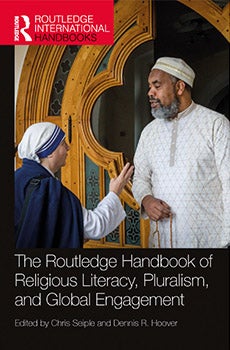Reviewed by Moses Biney, Department of Sociology and Brenton Kalinowski, Department of Sociology
The Routledge Handbook of Religious Literacy, Pluralism, and Global Engagement edited by Chris Seiple and Dennis R. Hoover offers a comprehensive understanding of cross-cultural religious literacy, emphasizing the presence of diversity and the mutually respectful engagement of difference to which the theory and application of religious literacy should be directed. The handbook is organized into three sections, each addressing a key question: What is religious literacy? Who needs religious literacy? And where can religious literacy and covenantal pluralism make a difference? By delving into these topics, the book contributes to the field of religious literacy by highlighting its significance, the presence of religious diversity within societies, and the necessity for respectful engagement.
One of the significant contributions of the volume as a whole is the editors’ introduction of the concept of “Covenantal Pluralism” which is a practice that “embodies the humility, patience, empathy, and responsibility to engage, respect, and protect others without necessarily equating their beliefs and behaviors with one’s own” (14). Drawing on the insights of diverse writers from various cultural and religious backgrounds, the handbook offers perspectives on covenantal pluralism and religious literacy grounded in their respective contexts. Part I of the book focuses on Covenantal Pluralism from different religious perspectives shedding light on how each world religion strongly supports religious literacy and covenantal pluralism within its own beliefs. By showcasing reflections from Judaism, Catholicism, Protestantism, Islam, Hinduism, Buddhism, Chinese religions, and Secular Humanism, each chapter’s respective author(s) demonstrates the potential for individuals of any religious background to find common ground and consensus on religious pluralism and literacy.
The applied uses of the volume shine through in parts II and III which focus on applications and cases studies of cross-cultural religious literacy and covenantal pluralism. Specifically, Part II includes 9 chapters each discussing a different professional field, such as higher education, international diplomacy, and the corporate sector that the authors argue could benefit from the inclusion of greater religious literacy. It is notable that many of these chapters cover fields that intersect with government activity and utilize public funding. In these instances, the authors are thoughtful in the way they respond to potential criticism of the proposition that federally funded enterprises should engage with religion. For example, in her chapter on bringing greater religious diversity into international development and humanitarian efforts, Katharine Marshall notes that it is contentious whether or not the World Bank should be involved with local religious institutions and that religion is seen by some as standing in the way of development. Marshall argues that by taking an approach to religious pluralism that emphasizes similarities rather than differences the potential upside and increased outreach that can be gained by working with local religious institutions is great. The 14 case studies of Part III of the volume focus on instances of conflict and the ways in which covenantal pluralism can be applied to solve such conflicts. A wide range of countries and regions are covered in Part 3 such as Laos and Vietnam, India, Pakistan, Latin America, and the United States. Each chapter is written drawing from the perspective and experience of a leading practitioner of inter-faith engagements. Seiple and Hoover argue that the implementation of religious literacy in instances of disagreement in conflict is to first gain an understanding others’, as well as one’s own, identity before building a relationship with the capacity to meaningful engagement.
While the breadth of cultural backgrounds and professional fields covered in the book’s 33 chapters across roughly 450 pages is a great strength, a common challenge for an edited volume, such as this, is to maintain a cohesive vision and terminology across the entire work. While, in the whole, the selection of authors and topics helps to keep the book focused, terms such as covenantal pluralism and religious literacy can be interpreted and used differently across the volume which can, at times, be detrimental to the editors’ greater theoretical arguments. The book is also best read as a collection rather than as a quick reference for practitioners interested in one or two fields as it may be difficult to follow along at certain points without having reviewed other portions of the book.
In any increasingly globalized world where many local contexts are seeing a rise in religious pluralism, this volume is an essential read for a number of audiences including religious leaders and lay people interested taking part in interfaith engagement; scholars in religious studies and the social sciences focusing on religious conflict and diversity; and practitioners in numerous professional fields such as development and education who are seeking to make religious literacy a greater part of their work.

